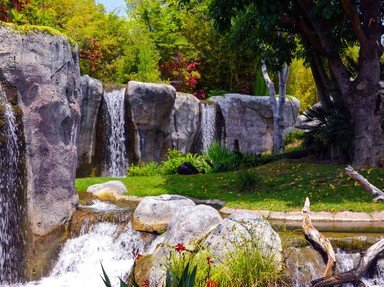Quiz Answer Key and Fun Facts
1. The bright yellow stripes make it relatively easy to spot and identify a corroboree frog in its display, one of the first we see as we enter the zoo. What makes these two species of frog unique?
2. After passing the chimpanzees, it is easy to spot the giraffe enclosure, just across the path from the Centenary Theatre, where wildlife and conservation films are screened at regular intervals. Taxonomists disagree as to the number of living species of giraffe, but they do agree that there is only one other member of the same family, the Giraffidae. Which of these is it?
3. No stopping at the Food Market, and passing the lemurs as we go, we reach the Tasmanian devil display. What is the diet of the Tasmanian devil (Sarcophilus harrisii)?
4. Next stop on our tour is home to several clans of meerkat (Suricata suricatta). Where would I need to travel to find meerkats in the wild?
5. Just across from the meerkats we spot this squirrel-sized animal, a New World monkey related to the marmoset. While scientists describe them as belonging to the genus Saguinus (with this one specifically being Saguinus oedipus), most people refer to them using which of these names?
6. Passing the Food Market again, and staying on the main track, instead of the Rainforest Trail shortcut, we reach the sun bears (Helarctos malayanus). Taronga Zoo has (as of the time of writing this quiz) two sun bears, named Mary and Mr Hobbs. As their species name suggests, they come from Southeast Asia. What is their preferred habitat in their native countries?
7. It's not the right time for the Free Flight Bird Show, so on past the tortoises we proceed, to the condor enclosure. Condors are the largest flying land-based birds in the Americas. To which of these birds are they most closely related?
8. The next display as we proceed downhill contains one of Africa's largest antelopes, Tragelaphus eurycerus. What is its percussive-sounding common name?
9. Across the path from the wetland aviary, and just before the seals, we find the red pandas. The red panda (Ailurus fulgens) is taxonomically placed in its own family (Ailuridae), which is part of the superfamily Musteloidea. To which of these animals is it LEAST closely related?
10. For our final stop today, we have to choose between the seal show and the penguin show, both on at the same time. After the toss of a coin, it's on to the penguins. The smallest species of penguin is the little penguin (Eudyptula minor), which is found along the southern coasts of Australia and New Zealand. In New Zealand, they are usually called blue penguins (or by their Maori name, korora). What is their common Australian name?
Source: Author
looney_tunes
This quiz was reviewed by FunTrivia editor
rossian before going online.
Any errors found in FunTrivia content are routinely corrected through our feedback system.
